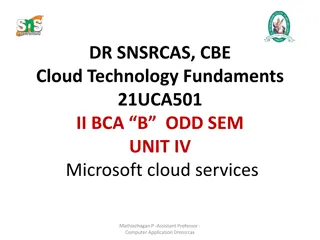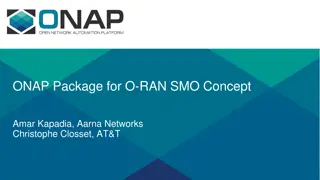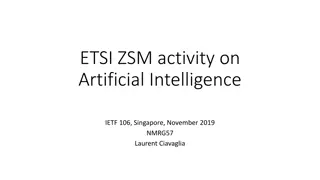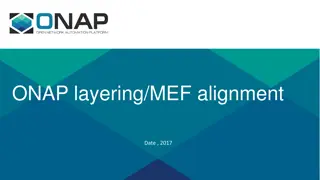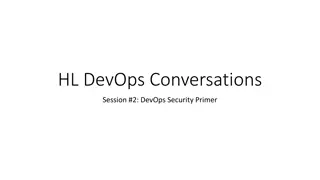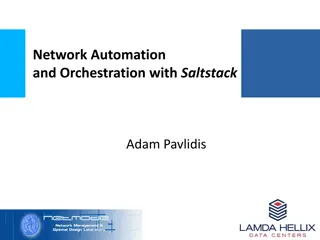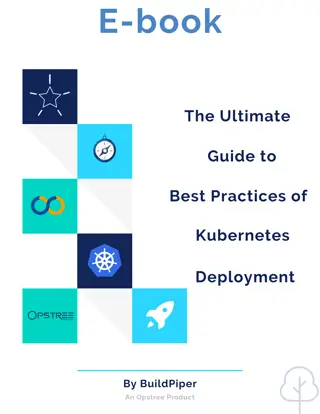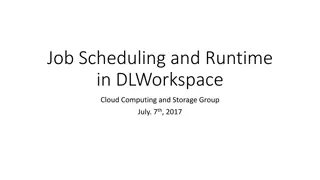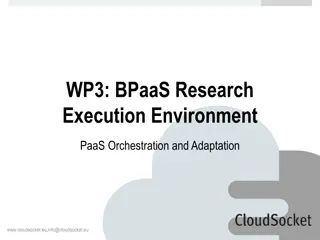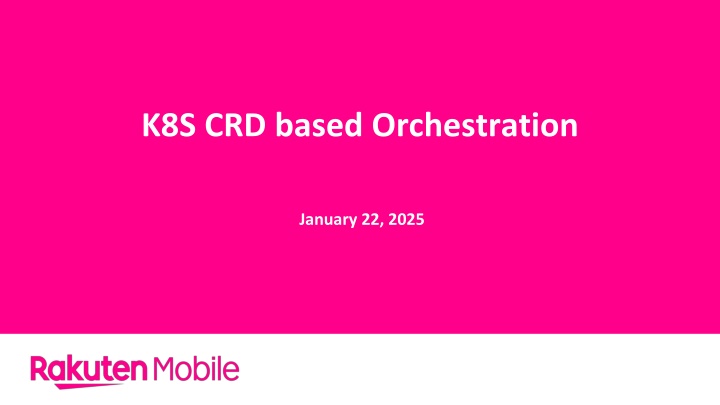
Optimizing K8S CRD-Based Orchestration for Multi-Vendor Cloud Environments
Explore the challenges and benefits of standardized CRDs in Kubernetes-based orchestration systems for managing resources in multi-vendor cloud environments. Addressing issues with interoperability and resource optimization, learn how standardized CRDs can enhance deployment requirements and foster centralized management in cloud infrastructures.
Download Presentation

Please find below an Image/Link to download the presentation.
The content on the website is provided AS IS for your information and personal use only. It may not be sold, licensed, or shared on other websites without obtaining consent from the author. If you encounter any issues during the download, it is possible that the publisher has removed the file from their server.
You are allowed to download the files provided on this website for personal or commercial use, subject to the condition that they are used lawfully. All files are the property of their respective owners.
The content on the website is provided AS IS for your information and personal use only. It may not be sold, licensed, or shared on other websites without obtaining consent from the author.
E N D
Presentation Transcript
K8S CRD based Orchestration January 22, 2025
Background for Declarative systems Declarative systems incorporate Requirements In declarative state Managing Software Watches the declarative state for changes Adjusts resources to represent the latest declarative state Current status Represents latest state of resources Resources Modifications represents Declarative state + Current status Future state State change Update status to match adjust Managing software Current state 2
Custom Resource Definitions in K8S K8S operator pattern Schema Represented by CRD Requirements Represented by CR Managing Software Watches the declarative state for changes Adjusts K8S resources to represent the latest declarative state Current status Represented in CR K8S Cluster for workloads Modifications represents K8S CR Future state (Declarative state + Current status) State change Update status to match adjust K8S Operator (Managing software) Current state 3
Problems Today with K8S CRD in Multi-Vendor Cloud Environment 3GPP management system has no way to understand the content in the CRs, and to retrieve or construct the deployment requirement information to modify, coordinate or jointly optimize the resource. 3GPP management system CR based on CRD schema B CR based on CRD schema A Communication service providers work with vendor-specific helm charts or CRs to manage NFs Orchestration system (K8S based) Operator (vendor B) Operator (vendor B) Orchestration system (K8S based) Operator (vendor A) Operator (vendor A) Vendor-specific CRDs There is no interoperable way for 3GPP management system to define the deployment requirements for each vendor s NF. Each vendor manage its own NFs independently in isolated cloud resources, i.e. separate clusters or namespaces A user employed by the service provider creates separate artifacts for each vendor 3GPP NF workload (vendor A) 3GPP NF workload (vendor B) 3GPP NF workload (vendor A) 3GPP NF workload (vendor B) Management system cannot modify the deployment requirements in the CRs. There is a strong need to standardize the CRD schema for different types of 3GPP NFs in RAN and core, to enhance interoperability in multi- vendor NFs cloud environment. Cluster A Cluster B There is no centralized management, runtime resource coordination and joint optimisation Cloud Infrastructure 4
Benefits of Standardized CRD for Multi-Vendor Cloud (Single-Tenant Dedicated Resource) 3GPP management system can understand the CR content for each vendor NF s deployment and manage the resource allocation through retrieving and constructing requirement information from/to the CRs 3GPP management system CR based on standardized schema CR based on standardized schema Uses standardized CRDs Orchestration system (K8S based) Operator (vendor B) Operator (vendor B) Orchestration system (K8S based) Operator (vendor A) Operator (vendor A) Each vendor s operator still manage its own NFs in isolated cloud resources. 3GPP NF workload (vendor A) 3GPP NF workload (vendor B) 3GPP NF workload (vendor A) 3GPP NF workload (vendor B) The management system can modify the NF deployment (part of LCM requirements ) to coordinate or jointly optimize the resource in runtime. Cluster/namespace-A Cluster/namespace-B Cloud infrastructure Single-tenant dedicated resource e.g. isolated cluster or namespace multi-vendor cloud 5
Benefits of Standardized CRD for Multi-Vendor Cloud (Multi-Tenant Shared Resource) Example 1: DU, CU-CP and UPF are collocated at the edge and are jointly optimized 3GPP management system can understand the CR content for each vendor NF s deployment and manage the resource allocation through retrieving and constructing requirement information from/to the CRs 3GPP management system CRD common Orchestration system (K8S based) 3GPP management system Operator (common) (common) Operator CR based on standardized schema DU CU-UP (vendor B) UPF (vendor A) (vendor C) Orchestration system (K8S based) The system integrator manages both NFs from vendor A and B based on standardized CRD schema. Edge cloud cluster Operator (common) (common) Operator Example 2: Multi-vendor slice with dynamic slice SLA assurance 3GPP management system frequency CRD common When the traffic demand of Slice B increases, re- allocate resource to slice B to guarantee the bit rate and latency 3GPP NF workload (vendor B) 3GPP NF workload (vendor A) 3GPP NF workload (vendor B) 3GPP NF workload (vendor A) e.g. multi-vendors NF share the same cluster and are jointly managed by the common operators Orchestration system (K8S based) Operator (common) (common) Operator Cluster/namespace common Latency and bit rate guaranteed slice Best effort slice Cloud site time UPF, CU-UP (vendor B) Multi-tenant shared resource DU resource allocated for slice A (vendor A) DU e.g. Multi-vendor NFs shares single cluster or namespace resource allocated for slice B (vendor B) Edge cloud cluster 6
Example based on standardized CRD for UPF CRD_UPF Interface NF logical interface definitions, mapping with network interfaces 3GPP management system >n3 >n4 >n6 CR_UPF The CR express the high-level requirements of the 3GPP NF deployment Capacity requirements >maxUplinkThroughput >maxDownlinkThroughput More capacity requirements e.g. Orchestration system (K8S based) Dependency Operator Operator >smfRef Network endpoints >vpcN3 >vpcN4 >vpcN6 Resource requirements (optional) ->resourceConstraint The orchestration system (operators) automatically allocate resources to the NF workloads to achieve requirements UPF workload (vendor A) UPF workload (vendor A) UPF workload (vendor A) Node Node Node Network interface definitions, IP/FQDN configurations, mapping with NF logical interfaces Cluster Resource requirement or constraint for the 3GPP NF deployment, e.g. CPU/RAM/storage capacity, NUMA awareness, node binding etc. Ref: Nephio Linux Foundation Project 7
Creation of NF instance using 3GPP-defined CRD CRD_UPF Interface >n3 >n4 >n6 Capacity requirements >maxUplinkThroughput >maxDownlinkThroughput Example CRD Dependency >smfRef Network endpoints >vpcN3 >vpcN4 >vpcN6 Resource requirements (optional) ->resourceConstraint 8
Conclusion The solution enhances interoperability, cost efficiency in multi-vendor cloud in both single-tenant as well as in multi-tenant cluster environments. The standardized CRDs shall Provide a high-level declaration on what to be achieved by the orchestration system (the deployment requirements) The how is achieved by vendor-specific operator implementations. Focuses only on taking the common, non-differentiating aspects of 3GPP NFs Vendor extensions will enable cloud, NF and orchestration vendors to develop unique and critical value they can bring. Using the standardized CRD schemas, the 3GPP management system can Retrieve vendor specific deployment requirements from the CRs, configure cloud infrastructure and make NF deployment placement decisions accordingly. Construct new deployment requirements to modify the current deployments (part of LCM requirements) 9
Example Information Model for CRD CRD_CUUP Interface >e1 >f1u >n3 Capacity >maxUplinkThroughput >maxDownlinkThroughput Dependency >cuupRef Network >vpcE1 >vpcF1u >vpcN3 Resource (optional) ->resourceReq ->resourceConstraint 10

